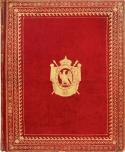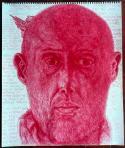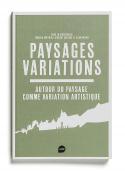Art Of The Day Weekly
#379 - from 12 March 2015 to 18 March 2015
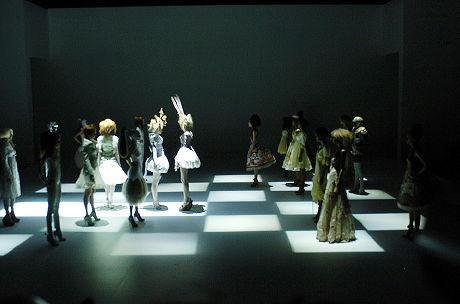
Alexander McQueen, It’s Only a Game, Spring/Summer 2005. Image: firstVIEW. Courtesy V&A Museum, London.
IN THE AIR
McQueen, the James Dean of fashion
LONDON – To know the rules in order to better breach them, to breach them to better defend the tradition: such were some of the provocative leitmotif of Alexander McQueen (1969-2010), the “enfant terrible” of the fashion world whose career lasted the span of a meteorite. He was the son of a taxi driver, a tailor at the age of 16, an agitator and an instigator who combined all that influenced him –gothic, Japan, the Orient, the history of Scotland, and in the 1990s and 2000s he met world success before his suicide gave him an immediate status in the pantheon of fashion. Following the phenomenal success of the American exhibition with 650 000 visitors at the Metropolitan in New York in 2011, the same brings the creator back to Europe and presents all the facets of his career, from 1992 –the year in which he got his diploma from Central Saint Martins – up to his last collection in 2010.
• Alexander McQueen, Savage Beauty at the Victoria & Albert Museum, 14 April to 2 August 2015.
EXHIBITIONS
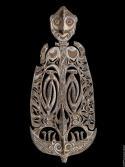
Malu panel, Ethnologisches Museum Berlin © Staatliche Museen zu Berlin – Preußischer Kulturbe-sitz, Ethnologisches Museum, Foto: Claudia Obrocki
Sepik, the ancestors in Papua New Guinea
BERLIN – Imagine a river as long at the French Loire where the populations along the river bank spoke one hundred different languages. This is the case of the Sepik river which goes across a part of Papua-New Guinea and which was ignored by the Western world until 1886 when the German colonialists baptized it (the river’s mouths were discovered much later, in 1914). The museum is celebrating the centennial of a pioneer ethnographic expedition, and relies on the collections from Berlin and other foreign institutions to draw up a panorama of this “primitive” art which so impressed the European avant-gardes. Masks, sculpted boats, headdress, trunks from the stilt houses: all refer to the strength of the ancestors who ensure the world’s proper operating mode and who may only be invoked by using a precise ritual very cautiously.
• Dance of the Ancestors, Art from the Sepik of Papua New Guinea at Martin-Gropius-Bau, 18 March to 14 June 2015.
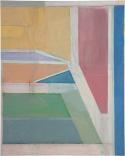
Richard Diebenkorn, Ocean Park #27, 1970. Oil on canvas, 254 x 203.2 cm. Brooklyn Museum. Gift of The Roebling Society and Mr. and Mrs. Charles H. Blatt and Mr. and Mrs. William K. Jacobs, Jr., 72.4
Diebenkorn, the forgotten American
LONDON – In Europe he is one of the least known of the great American painters of the post-war era. Richard Diebenkorn (1922-1993) operated very original transfers between abstract and figurative art forms. He was a renowned member of the abstract expressionist movement, and he then used his colorful pallet, full of ochers from New Mexico and the blue of the ocean, to do figurative art that turned him into one of the leaders of the Californian school of the Bay Area; and that was before he finished his career with the chromatic puzzles from Ocean Parks. This exhibition, the first one of such a span in Europe for the last 25 years, presents nearly fifty of his main paintings.
• Richard Diebenkorn at the Royal Academy of Arts, 14 March to 7 June 2015.
These exhibitions also open this week...
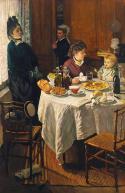
Claude Monet, The Luncheon, 1868, oil on canvas, 231,5 x 151 cm, Städel Museum, Frankfurt am Main. Photo: Städel Museum – ARTOTHEK © Städel Museum, Frankfurt am Main
Monet in Germany
FRANKFURT – Today he is world famous, but one had to be rather audacious to buy one of his works one hundred years ago. The Städel Museum celebrates its bicentennial with a foreseeable success – this retrospective that follows Monet's career – but this is not simply a special show. The museum was actually one of the first buyers of the artist's impressionist works and includes in its collections le Déjeuner (The luncheon). This painting created a scandal as it represented the living quarters of an illegitimate couple and was refused by the Salon in 1869. Aside from the inevitable French and American loans, the exhibition shows the unknown wealth of the German museums, from Berlin to Dresden and Hanover.
• Monet and the birth of Impressionism at the Städel Museum, 11 March to 21 June 2015.
The other Reynolds
LONDON – It is not necessarily easy to present Joshua Reynolds (1723-1792), the epidomy of the classical portrait artist, the founder of the Royal Academy, honoured by one and all, as an audacious experimenter. It is precisely that though that this exhibition tries to prove. To do so it feeds on the museum's invaluable collections and relies on years of analysis. It proves that the painter was an innovator both in the use of pigments as well as in the narrative format.
• Joshua Reynolds, Experiments in Paint at the Wallace Collection, 12 March to 17 June 2015.
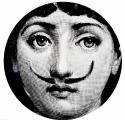
Piero Fornasetti, plate from the "Tema e Variazioni" series. Porcelain. Diametre 26 cm © Courtesy Fornasetti
The Fornasetti production
PARIS – Milan native Piero Fornasetti (1913-1988) was an unusual person, expelled from the School of Fine Arts of Milano but a relentless creator in many fields (interior architecture, textile design and furniture design, typography, painting, etc.). He resisted all attempts of classification. With no less than one thousand pieces from his archives, the retrospective gives a good idea of his polymorphic talents.
• Fornasetti, la folie pratique at the Arts décoratifs, 11 March to 14 June 2015.
AUCTIONS
Ode to Napoleon
PARIS – This is not the first time a library on Napoleon is auctioned. But this one is particularly interesting, with its 12 000 titles. The 862 lots, some of which including some ten works, will satisfy not only the fans of Austerlitz but the specialists of a given lieutenant-colonel as well. Indeed it offers a profusion of bulletins from the Grande Armée, notes on military life, catalogues of medals and military biographies. But there are also souvenirs, traveler’s diaries, campaign anecdotes and other posthumous memoirs –some of them hand-written-, signed by forgotten commandants and generals - Bacler d’Albe, Berthezène or Boulay de la Meurthe – as well as by “stars” such as Jourdan and Murat. The Relation de la bataille de Marengo , in which the death of the extraordinary Desaix is described, by Berthier, is a jewel due to its typography and its binding, in a large in-folio form, which should not sell for less than €12 000.
• Bilbiothèque napoléonienne, 12 and 13 March 2015 at the hôtel Drouot (SVV Thierry de Maigret).
ARTIST OF THE WEEK
In Beaudelère's eyes
He shows up at the exhibition with a Batman mask on. So we will not see his face, even though it is the obsessional theme of the work. Karl Beaudelère, who, out of love for the famous poet chose a transparent name, prefers to come forward hidden, like the Mexican wrestlers. His life, or the part he accepts to unveil, could be the subject of a good novel: he is a Jack of all trades. Wood gilder, security officer, neighborhood antique dealer are some of the odd jobs he had until he applied for a patent in embossed stained glass and was ruined. He could barely survive and buy ballpoint pens at the supermarket. He used to start some ten years ago his corpus of self-portraits. The numerous serpentine lines that make up his face make us think of those by Giacometti when he drew James Lord or of the automatic drawings by Julien Salaud, one of his contemporaries, who painted them in the métro. An obsession with the trait which takes him nearly a month for each page with the purpose of finding the “real head”, the “sincere face” which the other Baudelaire was also in search of.
• Karl Beaudelère, face à face at the galerie Routes (53, rue de Seine, 75006 Paris), 5 to 14 March 2015.
BOOKS
Latest news about landscapes
What part does man play in landsapes? Is there such a thing as an urban landscape? Can a landscape be "national"? This book reports on various round tables held at the contemporary art center of la Maréchalerie, and addresses these questions by comparing works by artists and theoriticians. Certain anecdotes are quite clarifying, such as a Californian company that makes millions by painting in green lawns that have gone yellow during the summer, or the Gulf countries that need to import sand to make their cement. But it also shows the concept of a landscape is not set, it is constantly renewed - recently with the idea of a "sound landscape" - and it has been globalized since a long time nows. Artist Karine Bonneval organises in a video lthe absurd accompaniement of a foreign plant like the Canadian 'vergerette' while Gilles Clément develops his notion of a "third landscape" like a "third party". This eternal but disregarded reservoir – banks of highways, slanted fields, wastelands – all appear in his remarkable project, that of a garden on a cement slab on the submarine base of the port of Sainte-Nazaire.
• Paysages variations, directed by Manola Antonioli, Vincent Jacques and Alain Milon, éditions Loco, 2014, 176 p., €28.
OPENINGS OF THE WEEK

JOAN AYRTON - FAST COLOUR
14 March 2015 - PARIS - Florence Loewy
An artist looking for the concept of colour
IN BRIEF
DUBAI - The modern and contemporary art fair Art Dubai is being held from 18 to 21 March 2015.
HONG KONG – The modern and contemporary art fair Art Basel Hong Kong is being held from 15 to 17 March 2015.
MAASTRICHT – The TEFAF antiques art fair is being held from 13 to 22 March 2015.

